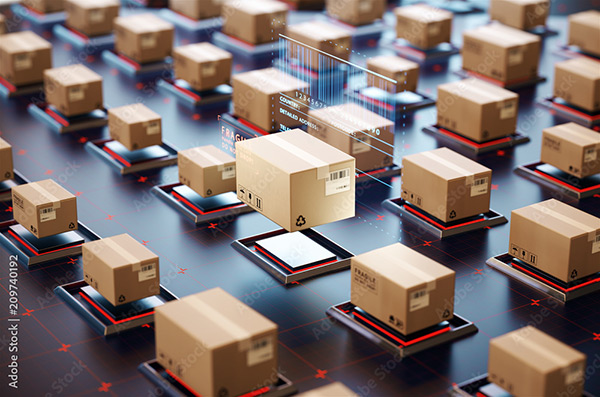When combined, the two technologies break distribution center bottlenecks and enable complete inventory visibility.

Warehouses are buckling beneath the pressure of demand, as e-commerce volumes continue to rise and global supply chains remain in gridlock. Inventory needs to be shipped, and fast, but labor shortages are directly impacting distribution centers. What can be done?
Over the years, automation technologies have gained momentum with the rise of robotic systems capable of moving and sorting inventory. While these solutions have greatly streamlined warehouse operations, inventory visibility has been largely left out of the conversation. This has placed warehouse operators in the dark when it comes to critical data, such as product quality assurance and the health of sorting systems.
Thankfully, there are ways to gain full visibility into the distribution lifecycle so that sorting and shipping never grind to a crawl. By leveraging the power of artificial intelligence (AI) and image recognition, warehouses can eliminate guesswork to gain complete inventory visibility and enhance automation and throughput.
Warehouses receive and process millions of packages each day. That means there is very little room for error and enormous amounts of potential data being generated every second. Distribution centers, however, largely leave this valuable resource untapped and choose to run more manual processes that can become failure points and create major bottlenecks.
When captured and analyzed effectively, data can be a game changer for streamlining operations. Specifically, understanding the quality of inventory and gaining traceability to know where everything is in real time.
But first, how is this information acquired? Package data can be captured at the tunnel and facility levels by placing sensors in the form of cameras. There, sensors snap photos that reveal far more information than could be managed by a single individual. The best part, though, is the data collected by these sensors shares more than just what’s happening with inventory. Since they are placed at the tunnel and facility levels, this means that distribution centers also glean data that tells them exactly how their tunnels are performing, in addition to sorting capacity at different time periods.
Image Recognition
For logistics companies, products must meet specific quality assurance standards. This means barcodes should be clearly legible and labels easily detectable, along with various other packaging standards and specifications that are outlined by their customers. Failure to meet these requirements results in chargebacks that can cause significant financial burden. So how can errors be prevented and quality assurance maintained?
If a picture is worth a thousand words, then an image captured within the warehouse is worth a thousand data points. Photos reveal, in real time, the condition of inventory when it arrives by sharing information about all six sides of a package, providing a holistic understanding of quality. Images that are acquired within the tunnels are then stored, generally via the cloud, to build a catalog of products. This creates an immense amount of valuable data – but sensor technology alone cannot interpret it.
Artificial Intelligence
Artificial intelligence is no longer a “nice to have,” it’s a need to have. Perhaps the greatest value AI brings to the supply chain is that it augments throughput without disrupting the existing operational stack. While robotic technology has been deployed within warehouses, there is a lack of software able to interpret inventory data to provide personnel with visibility into the complete distribution lifecycle. However, when coupled with image recognition, AI becomes tremendously powerful. AI is able to read what is displayed in the photo and provide feedback. Everything from barcodes to label detection can be processed, analyzed, and stored with AI.
Because AI is capable of learning, AI models that are trained well will be able to identify the source of many common problems. One of the biggest advantages of utilizing AI in this capacity is that it does not require coding knowledge to operate, nor assistance from data scientists for model creation. And there’s an added plus: AI can often be integrated with existing warehouse technology, creating a fully automated workflow.
To get even more granular, AI models can be trained and deployed to serve specific business needs, such as being designed for a specific type of package detection so that sortation can be automated. For example, if a model is trained to recognize the hazmat symbol, it knows that those packages must be handled with care.
The global supply chain continues to be under stress, from increased e-commerce orders to labor shortages to rising customer expectations. In order to survive, distribution centers must evolve by adopting technologies that enable greater automation.
While technology has come to the warehouse, largely in the form of autonomous robotics solutions, image recognition and AI can be the “light switch” that provides visibility into the once-dark distribution lifecycle.
Together, image recognition and AI eliminate guesswork, enable greater visibility, and provide automation that will be the deciding factor in which companies can deliver on their promises to customers.

John Dwinell is the founder and CEO of Siena Analytics, an AI company born in the distribution center focusing on supply chain visibility and automating quality assurance for logistics operations. Prior to Siena Analytics, John was the Vice President of Emerging Technology at Sick Sensor Intelligence, a leader in the industrial sensor and applications market. He holds a master’s degree in computer science from Boston University.
Scott Ellyson, CEO of East West Manufacturing, brings decades of global manufacturing and supply chain leadership to the conversation. In this episode, he shares practical insights on scaling operations, navigating complexity, and building resilient manufacturing networks in an increasingly connected world.